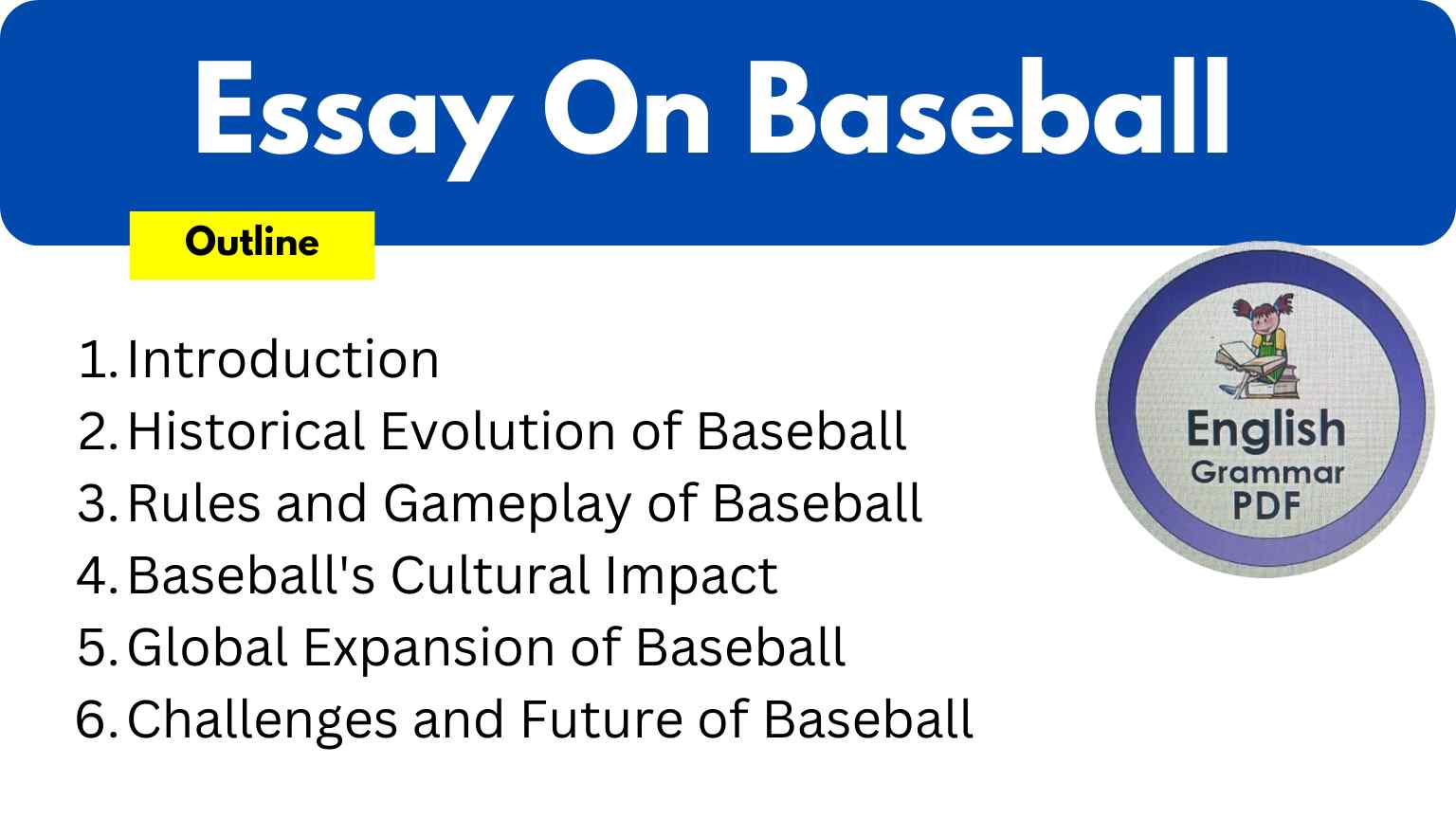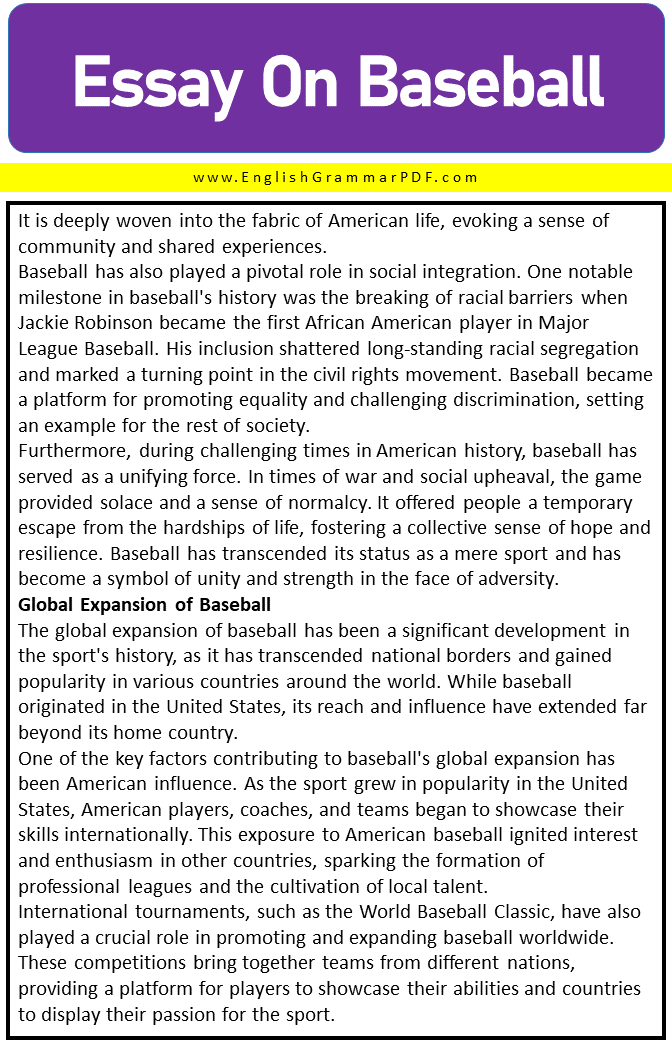Essay On Baseball
Outline of Essay:
- Introduction
- Historical Evolution of Baseball
- Rules and Gameplay of Baseball
- Baseball’s Cultural Impact
- Global Expansion of Baseball
- Challenges and Future of Baseball
Introduction
Baseball, a sport that has captured the hearts of millions, is a quintessential part of American culture. Defined as a bat-and-ball game played between two teams of nine players each, baseball holds a rich history and has evolved into a global phenomenon. This essay will explore the origins and development of baseball, delve into its rules and gameplay, examine its cultural impact, discuss its global expansion, and analyze the challenges it faces and its prospects.
Historical Evolution of Baseball
Baseball’s roots can be traced back to ancient ball games played in various civilizations. However, it was in England and other countries that early forms of baseball emerged. The game was then modernized by Alexander Cartwright, a founding member of the Knickerbocker Base Ball Club. The Knickerbocker Rules, which Cartwright helped create, played a crucial role in shaping the game as it evolved. As baseball grew in popularity, professional leagues such as the National League and the American League were formed, and the sport witnessed the rise of legendary players like Babe Ruth and Ty Cobb.
Rules and Gameplay of Baseball
The rules and gameplay of baseball form the foundation of this beloved sport. Understanding the intricacies of the game is essential for players and fans alike. At its core, baseball involves two teams, each consisting of nine players, competing to score runs.
The basic objective of baseball is to score more runs than the opposing team. A run is scored when a player successfully crosses all four bases, starting from home plate. The field is divided into fair territory and foul territory, with the fair territory encompassing the infield and outfield.
The offense takes its turn at bat, aiming to hit the ball thrown by the pitcher. The batter must try to hit the ball within the designated boundaries, avoiding fouls. If the batter successfully hits the ball into play, they can attempt to reach base and advance further. The offense can score runs through various means, including hitting the ball out of the park for a home run or executing a combination of hits, stolen bases, and timely base running.
On the defensive side, the team on the field aims to prevent the offense from scoring. The pitcher plays a crucial role, delivering the ball toward home plate with the intent to strike out the batter or induce a hit that can be fielded. The remaining eight defensive players are positioned strategically across the field, ready to field the ball and make plays.
Baseball is known for its strategic elements, with teams employing different defensive alignments, pitch selection, and base running strategies. Coaches and managers analyze statistics and employ analytics to evaluate players and devise game plans. Statistics like batting average, earned run average (ERA), and on-base percentage are commonly used to assess player performance and determine optimal strategies.
Baseball’s Cultural Impact
Baseball’s cultural impact is profound, particularly in the United States, where it has earned the title of the national pastime. It holds a special place in American culture and is deeply ingrained in the country’s identity. The sport embodies values such as teamwork, perseverance, and fair play, which are revered as essential virtues in American society.
One significant aspect of baseball’s cultural impact is its symbolism in American culture. It represents the essence of the American spirit, reflecting the nation’s history, traditions, and values. The sport is often associated with nostalgia, conjuring images of small-town ballparks, hot dogs, and the sound of a bat cracking against a baseball. It is deeply woven into the fabric of American life, evoking a sense of community and shared experiences.
Baseball has also played a pivotal role in social integration. One notable milestone in baseball’s history was the breaking of racial barriers when Jackie Robinson became the first African American player in Major League Baseball. His inclusion shattered long-standing racial segregation and marked a turning point in the civil rights movement. Baseball became a platform for promoting equality and challenging discrimination, setting an example for the rest of society.
Furthermore, during challenging times in American history, baseball has served as a unifying force. In times of war and social upheaval, the game provided solace and a sense of normalcy. It offered people a temporary escape from the hardships of life, fostering a collective sense of hope and resilience. Baseball has transcended its status as a mere sport and has become a symbol of unity and strength in the face of adversity.
Global Expansion of Baseball
The global expansion of baseball has been a significant development in the sport’s history, as it has transcended national borders and gained popularity in various countries around the world. While baseball originated in the United States, its reach and influence have extended far beyond its home country.
One of the key factors contributing to baseball’s global expansion has been American influence. As the sport grew in popularity in the United States, American players, coaches, and teams began to showcase their skills internationally. This exposure to American baseball ignited interest and enthusiasm in other countries, sparking the formation of professional leagues and the cultivation of local talent.
International tournaments, such as the World Baseball Classic, have also played a crucial role in promoting and expanding baseball worldwide. These competitions bring together teams from different nations, providing a platform for players to showcase their abilities and countries to display their passion for the sport. The global audience and media coverage of these tournaments further enhances the visibility and appeal of baseball on an international scale.
Professional leagues have emerged in various countries, contributing to the growth and development of the sport. For instance, Japan’s Nippon Professional Baseball (NPB) league is highly regarded and boasts a rich baseball culture. The Dominican Republic has also made significant strides, producing a plethora of talented players who have excelled in Major League Baseball (MLB). Other countries, such as Cuba, South Korea, and Venezuela, have also seen the rise of competitive baseball leagues.
The influx of international players into MLB has added further diversity and excitement to the sport. Players from Latin America, Asia, and other regions have brought their unique skills and styles of play, enriching the game and fostering cultural exchanges.
The success of international players, such as Ichiro Suzuki from Japan and Vladimir Guerrero from the Dominican Republic, has helped popularize baseball in their respective countries and inspire future generations.
Challenges and Future of Baseball
The future of baseball faces several challenges that require careful attention and proactive measures to ensure its continued success and relevance. One of the significant challenges is the increasing competition from other sports and entertainment options. In today’s digital age, people have a plethora of choices when it comes to how they spend their leisure time. With the rise of e-sports, streaming services, and other forms of entertainment, baseball needs to find ways to captivate and engage new generations of fans.
Another pressing challenge is the declining youth participation in the sport. As technology advances and sedentary lifestyles become more prevalent, fewer young people are choosing to play baseball. This decline in participation has a direct impact on the sport’s talent pool and future sustainability. To address this challenge, it is essential to invest in grassroots programs, schools, and community initiatives that promote and nurture youth participation in baseball.
Furthermore, baseball must adapt to the changing preferences and expectations of fans. The traditional pace of the game has been criticized for being slow and lacking excitement compared to more fast-paced sports. In response, the implementation of rule changes and innovations, such as instant replay and the pitch clock, has been introduced to speed up the game and increase its appeal.
To secure its future, baseball must also focus on expanding its global reach. While the sport has made significant strides in international growth, particularly through Major League Baseball (MLB) initiatives, there is still room for further expansion and development. Building strong international leagues, nurturing talent from different regions, and fostering a fan base beyond the United States are crucial steps in broadening baseball’s global footprint.
Additionally, embracing technology and analytics can enhance the fan experience and provide new insights into the game. The use of advanced statistics and analytics has become increasingly prevalent in baseball, influencing player evaluation, team strategies, and fan engagement. Continued investment in technology and data-driven innovations can help attract tech-savvy fans and create a more immersive and interactive experience.
FAQ’s
Why is baseball special?
Baseball is special because it combines athleticism, strategy, and tradition in a way that captivates fans. Its rich history, cultural significance, and enduring status as America’s national pastime contribute to its unique appeal.
Why is it called baseball?
The name “baseball” originates from the sport’s basic elements: bases and a ball. The objective of the game is to hit the ball and advance around a series of bases, ultimately scoring runs. The name accurately reflects the fundamental aspects of the sport.
Download the PDF of the Essay:
Explore More Essays:








